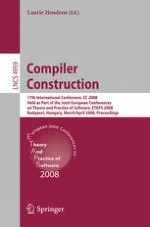2008 | Buch
Compiler Construction
17th International Conference, CC 2008, Held as Part of the Joint European Conferences on Theory and Practice of Software, ETAPS 2008, Budapest, Hungary, March 29 - April 6, 2008. Proceedings
herausgegeben von: Laurie Hendren
Verlag: Springer Berlin Heidelberg
Buchreihe : Lecture Notes in Computer Science
